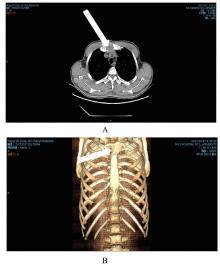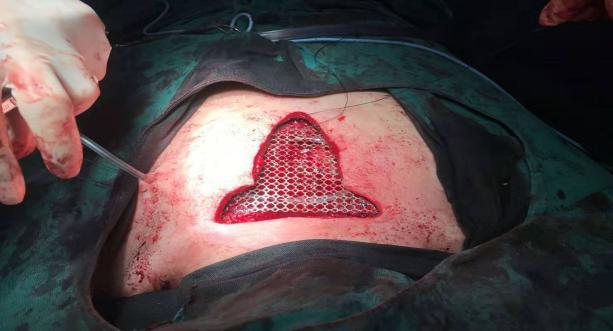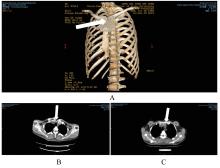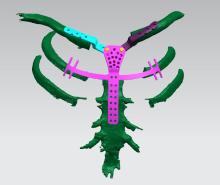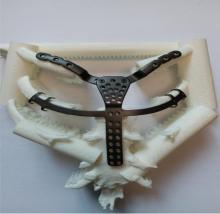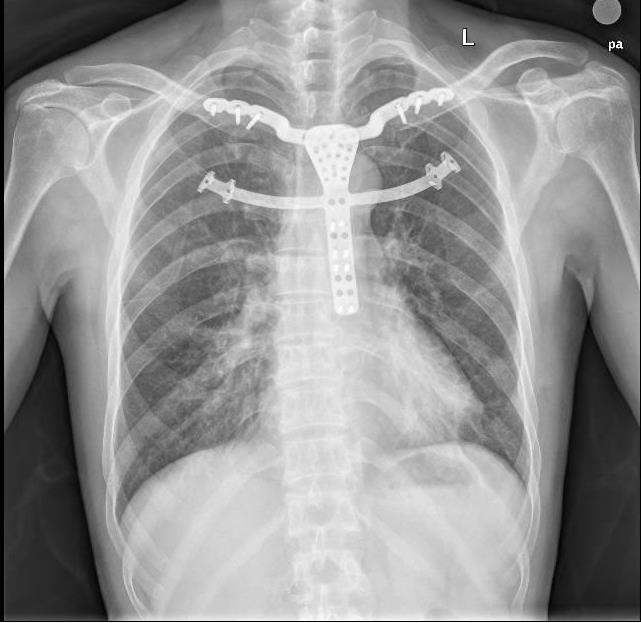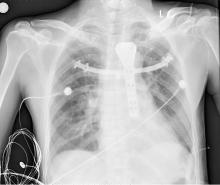| 1 |
黄晓锋, 单一波, 糜烨东, 等. 三维可视化技术在胸骨肿瘤切除和胸壁重建中的应用[J]. 武汉大学学报(医学版), 2023, 44(7): 829-832.
|
| 2 |
王 磊, 李 靖, 钟代星. 胸壁肿瘤切除及胸壁重建手术中国专家共识(2018版)[J]. 中国胸心血管外科临床杂志, 2019, 26(1): 1-7.
|
| 3 |
王 玲, 杨春成, 李涤尘, 等. 3D打印个性化聚醚醚酮胸肋骨假体实现胸廓重建[C].广州:特种加工技术智能化与精密化——第17届全国特种加工学术会议论文集,广州, 2017: 232.
|
| 4 |
LIPIŃSKA J, KUTWIN L, WAWRZYCKI M, et al. Chest reconstruction using a custom-designed polyethylene 3D implant after resection of the sternal manubrium[J]. Onco Targets Ther, 2017, 10: 4099-4103.
|
| 5 |
PENG Q, TANG Z G, LIU O S, et al. Rapid prototyping-assisted maxillofacial reconstruction[J]. Ann Med, 2015, 47(3): 186-208.
|
| 6 |
温小鹏, 高 山, 李 硕, 等. 3D打印技术应用于胸骨缺损修复的可行性研究[J]. 临床外科杂志, 2017, 25(8): 608-610.
|
| 7 |
SINGH A, CHANDRASHEKHARA S H, TRIVENI G S, et al. Imaging in sternal tumours: a pictorial review[J]. Pol J Radiol, 2017, 82: 448-456.
|
| 8 |
黄进丰, 张德超. 胸骨肿瘤的初步治疗经验[J]. 中国肿瘤临床与康复, 2004, 11(3): 250-252.
|
| 9 |
唐恋莎, 何文博, 陈 楠, 等. 原发性胸骨肿瘤的临床诊治进展[J]. 中国肿瘤外科杂志, 2021, 13(2): 200-205.
|
| 10 |
MCCORMACK P M. Use of prosthetic materials in chest-wall reconstruction. Assets and liabilities[J]. Surg Clin North Am, 1989, 69(5): 965-976.
|
| 11 |
吴安邦, 覃可乐, 朱 广, 等. 修复与重建大面积胸壁缺损的临床研究进展[J]. 现代生物医学进展, 2015, 15(2): 398-400.
|
| 12 |
王 波, 刘 青, 何 弢, 等. 同种异体冻干骨内固定治疗多发肋骨骨折28例[J].山东医药,2013,53(43): 104.
|
| 13 |
杨 博, 李 斌, 蒋 鹏, 等. 自体髂骨移植联合钛板胸骨重建一例 [J]. 中国胸心血管外科临床杂志: 1-5[2023-10-06].DOI:10.7507/1007-4848.202203063 .
doi: 10.7507/1007-4848.202203063
|
| 14 |
HAMEED A, AKHTAR S, NAQVI A, et al. Reconstruction of complex chest wall defects by using polypropylene mesh and a pedicled latissimus dorsi flap: a 6-year experience[J]. J Plast Reconstr Aesthet Surg, 2008, 61(6): 628-635.
|
| 15 |
张庆斌, 梅 宏, 韩连奎, 等. 胸壁肿瘤切除术胸壁缺损钛网重建五例[J]. 中国胸心血管外科临床杂志, 2014, 21(3): 424-425.
|
| 16 |
AZOURY S C, GRIMM J C, TUFFAHA S H, et al. Chest wall reconstruction: evolution over a decade and experience with a novel technique for complex defects[J]. Ann Plast Surg, 2016, 76(2): 231-237.
|
| 17 |
SCHMITZ M, SIRBU H, HORCH R E. Interdisciplinary treatment of extensive chest wall defects due to irradiation[J]. Chirurg, 2015, 86(9): 889-891.
|
| 18 |
HUMMELINK K, IJSSELDIJK M A, BOSCH A M, et al. Resection of a bony tumour of the chest wall with direct reconstruction using a sandwich technique: a standard technique for closure of large chest wall defects[J]. J Surg Case Rep, 2015, 2015(4): rjv040.
|
| 19 |
茅乃权, 左传田, 周元明, 等. 胸壁肿瘤的外科治疗[J]. 中国胸心血管外科临床杂志, 2005, 12(4): 299-300.
|
| 20 |
VANNUCCI J, SCARNECCHIA E, POTENZA R, et al. Dynamic titanium prosthesis based on 3D-printed replica for chest wall resection and reconstruction[J]. Transl Lung Cancer Res, 2020, 9(5): 2027-2032.
|
| 21 |
卢天健, 陈 楠, 廖 虎, 等. 3D打印技术在胸壁疾病外科领域应用的研究进展[J]. 中国胸心血管外科临床杂志, 2018, 25(11): 1003-1006.
|
| 22 |
戴志兵, 武俊申, 籍素芝, 等. 六例胸骨肿瘤的切除与重建报告[J]. 中国肿瘤临床与康复, 2021, 28(1): 41-45.
|
| 23 |
童兴和. 3D打印人工胸骨在胸骨切除术后胸壁重建中的临床应用研究[D]. 昆明: 昆明医科大学, 2019.
|
| 24 |
WEN X P, GAO S, FENG J T, et al. Chest-wall reconstruction with a customized titanium-alloy prosthesis fabricated by 3D printing and rapid prototyping[J]. J Cardiothorac Surg, 2018, 13(1): 4.
|
| 25 |
BELLIA-MUNZON G, MARTINEZ J, TOSELLI L, et al. From bench to bedside: 3D reconstruction and printing as a valuable tool for the chest wall surgeon[J]. J Pediatr Surg, 2020, 55(12): 2703-2709.
|
| 26 |
黎伟文, 黄东海, 黄代鸿, 等. 3D打印技术在胸廓畸形矫形手术的临床应用研究[J]. 中国医学创新, 2019, 16(13): 105-108.
|
| 27 |
张 颖, 林 琦, 袁 苑, 等. 3D打印个体化模板联合CT引导125I粒子植入治疗胸壁转移瘤1例[J]. 山东大学学报(医学版), 2016, 54(4): 94-96.
|
 )
)
